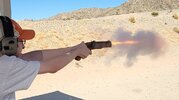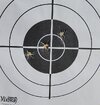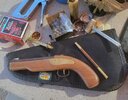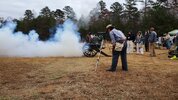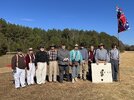You are using an out of date browser. It may not display this or other websites correctly.
You should upgrade or use an alternative browser.
You should upgrade or use an alternative browser.
A good day in one picture.
- Thread starter armoredman
- Start date
armoredman
Member
Sorry, computer jammed up. Pistol is a home built 54 made by a buddy gunsmith of mine. The only things on it that are factory are the barrel and lock. Everything else, trigger guard, trigger, sights, stock, (from a mesquite branch in his back yard), even the brass bits are home built. Sucker is accurate too. 11 paces.
Attachments
armoredman
Member
Armored farmer
Member
Nice pistol.
Your friend is very talented.
Your friend is very talented.
hawg
Member
Nice. I never would have guessed mesquite but then it doesn't grow around here. I would have thought maybe red oak.
Jackrabbit1957
Member
- Joined
- Apr 6, 2018
- Messages
- 2,874
It's loads of laughs to work with. Rotary tools and files are the best bet on shaping it. Really sharp chisels are a necessity as well. The grain changes direction a lot so using a plane or spokeshave doesn't work well. Another fun part is sand in the grain, if the tree was growing in a wash bed or river bottom you most likely will find sand in the grain.I've personally seen a rock the size of a baseball come out of an old growth Mesquite as well as nails and pieces of wire.
Acorn Mush
Member
Man, that must have been one tough neighborhood for Mesquite.Another fun part is sand in the grain, if the tree was growing in a wash bed or river bottom you most likely will find sand in the grain. I've personally seen a rock the size of a baseball come out of an old growth Mesquite as well as nails and pieces of wire.
armoredman
Member
We grow 'em tough down here.
Jackrabbit1957
Member
- Joined
- Apr 6, 2018
- Messages
- 2,874
As tough as it is to work the stuff it has a distinct beauty and figure that makes it worth it.
doubleh
Member
I love working with mesquite. My local source is limited as we only grow bushes here. Not enough rainfall, elevation is close to being too high for them, and the soil is shallow. There is a lot of our country they won't grow on. Our only condition that a mesquite loves is hot summers. I can find wood large enough for knife handles. 1911 grips, and sometimes single action grips. Anything larger has to be purchased from some place in Texas which seems to be mesquite heaven and it is expensive. I use to drive new pipeline right of ways with my jeep and a small chainsaw.in search of root balls for larger wood but there hasn't been a pipeline laid in my area for years so that source is gone.
Ugly Sauce
Member
- Joined
- Oct 26, 2020
- Messages
- 6,197
Twenty grains? Dang. Let that sucker stretch it's wings. My Plains Pistol .54 likes 75 grains of Swiss. I might think I had a failure to fire, or a squib, if I put twenty grains in it.Load shown was a 535 ball over 20 grains of 3F Olde Eynsford.
 However, I like it.
However, I like it.armoredman
Member
We just got it, but we have plans to try some other loads, including a Lee cast Minie ball, naked and paper patched. Yes, with 20 grains the recoil is VERY light, no argument there, but I was planning on keeping it down to what we load the other black powder handguns with, going up to probably 35 or so. Not out to thump the berm, just to have fun. 
armoredman
Member
Yikes, I just had a buddy cut down a huge mesquite tree in my backyard, going to dry the wood to use in the VFW Post for barbecues. Some of those logs would be big enough to make a full length Kentucky Long Rifle stock.I love working with mesquite. My local source is limited as we only grow bushes here. Not enough rainfall, elevation is close to being too high for them, and the soil is shallow. There is a lot of our country they won't grow on. Our only condition that a mesquite loves is hot summers. I can find wood large enough for knife handles. 1911 grips, and sometimes single action grips. Anything larger has to be purchased from some place in Texas which seems to be mesquite heaven and it is expensive. I use to drive new pipeline right of ways with my jeep and a small chainsaw.in search of root balls for larger wood but there hasn't been a pipeline laid in my area for years so that source is gone.
hawg
Member
20 grains is a brass frame revolver max load.  I'd probably start at 50 and work up from there.
I'd probably start at 50 and work up from there.
Ugly Sauce
Member
- Joined
- Oct 26, 2020
- Messages
- 6,197
I worked up to where recoil was still manageable enough to maintain a reasonable level of accuracy. That turned out to be 75 grains with a ball, and 65 grains with the 240 grain "PA conical", in my .50" barrel. I was mistaken when I said 75 grains in the .54" barrel with ball, my load for that is 70 grains. Now if I wasn't thinking about that wild, grouchy, and crazy Grizz fellow when I'm creeping around his mountain, I think 50 grains would be about right for general purposes. But nothing wrong with 40 grains either, if all one had to worry about was targets, gongs, coyote, wolf or Cougar. But that's just me.20 grains is a brass frame revolver max load.I'd probably start at 50 and work up from there.
SterlingBullet
Member
- Joined
- Jun 1, 2015
- Messages
- 305
Comments and questions:The Blind Squirrels had a good day as well. We won the Artillery match.
That appears to be extremely fine shooting with a cannon.
Everybody does seem to have dressed blind-folded.
What distance in the competition?
Why squirrels?
Why white pants?
Is that blue shirt truly a historical accurate fabric color?
armoredman
Member
Neither one of us is a recoil junkie. We don't anticipate carrying this anywhere but to the range and back. I will try it with some other loads next time we get out, and with that Lee Minie ball I cast up some time ago, but honestly, it is never gonna get worn out with the loads we use.20 grains is a brass frame revolver max load.I'd probably start at 50 and work up from there.
1- 100yd at reduced size howitzer targets. We shoot further at NationalsComments and questions:
That appears to be extremely fine shooting with a cannon.
Everybody does seem to have dressed blind-folded.
What distance in the competition?
Why squirrels?
Why white pants?
Is that blue shirt truly a historical accurate fabric color?
2- Ever hear the sayin- even a blind squirrel finds a nut occasionally?
3- Some units in the Confederacy wore white pants initially. Some wore completely white. For obvious reasons, they didn't stay white for long. The guys in the pic are our new guys. A notable example was the 26th Texas cavalry.
4- Yes it is. When trying to determine if a color is true to an original, you have to remember that they didn't have the colorfast dies back then we do now. Case in point, many original Confederate uniforms originally thought to be "butternut" were found to be gray originally when the inside of the seams were examined during conservation. Time, UV exposure, and wear turned the gray to tan or brown.
Dressed blindfolded? During the War, uniforms (when available in the South) came in 3 sizes- too big, too little and doesn't fit. Prior to the War, SC had a very well organized militia system. Even though the Militia Act of 1840 in SC set a standard uniform, it was often ignored, so militias were wearing what they could afford and the "rich" guys wore what they wanted and the poor guys wore what they had. That was the state of things when SC seceded and called up militia units for state service. Again, at that point, new uniforms for everybody were in short supply and many wore their militia uniforms/attire. This problem wasn't exclusive to SC by any means. Just look at the confusion during First Manasas with many units mistaking who was on what side for this very reason. The Palmetto Sharpshooters, aka Jenkin's Brigade was a unit made up from parts of 3 SC Infantry regiments that had already been campaigning for a year with no reissue of uniforms of any kind to replace what they went to war with and whose enlistments were expiring. They had initially signed for 1yr and the War certainly was going to last longer. Many of these early volunteer units had varied uniforms, if they had a complete one, or wore parts of their civilian/militia attire. So their uniforms, such as they had, varied widely and were in varying states of disrepair at that time and they were often wearing items of civilian clothing. Once the Sharpshooters were formed, it took a couple months to get completely reuniformed, and again, this was often done from multiple vendors and sources so colors varied a bit. The idea of Confederate units being properly and completely attired in gray is erroneous. Often the officers were correctly uniformed but they usually bought theirs out of their pocket from civilian tailors. The wide range of Confederate uniforms is a huge study by itself.
Finally, we aren't stitch counting reenactors. I used to run with that crowd back during the 125-130th anniversarys. The North South Skirmish Association is a COMPETITION shooting organization. While we do encourage as authentic dress as possible, it's not the main focus.
doubleh
Member
Every time I go to a Texas BBQ joint that has stacks of mesquite chopped up into firewood I think, "Darn, I would liked to have got ahold of a long piece of that".Yikes, I just had a buddy cut down a huge mesquite tree in my backyard, going to dry the wood to use in the VFW Post for barbecues. Some of those logs would be big enough to make a full length Kentucky Long Rifle stock.
Ugly Sauce
Member
- Joined
- Oct 26, 2020
- Messages
- 6,197
Oh yeah I get it. But I look at that generously size stock and can't help thinking that it would handle recoil pretty good. But for a paper-puncher, more recoil will just reduce accuracy. On the other hand, anything under 40 grains kind of puts it in revolver territory, and as they say...."what fun is that???"Neither one of us is a recoil junkie. We don't anticipate carrying this anywhere but to the range and back. I will try it with some other loads next time we get out, and with that Lee Minie ball I cast up some time ago, but honestly, it is never gonna get worn out with the loads we use.Perhaps just once I might give it 60 grains behind a Minie...maybe...
I shall add, I'm not really a recoil junkie either, (although not recoil sensitive) but if my rifle ever failed me, and I had to pull my pistol on Grizz, I don't think I'll feel the recoil at all. !!!!!

Bazoo
Member
Awesome new pistol. I'd like to see a close up detailed pic (instead of 10 foot off). I've never worked with mesquite wood before.
Bazoo
Member
Thanks for sharing. Would you recommend any pages/articles/books that would have solid information like that in it?1- 100yd at reduced size howitzer targets. We shoot further at Nationals
2- Ever hear the sayin- even a blind squirrel finds a nut occasionally?
3- Some units in the Confederacy wore white pants initially. Some wore completely white. For obvious reasons, they didn't stay white for long. The guys in the pic are our new guys. A notable example was the 26th Texas cavalry.
4- Yes it is. When trying to determine if a color is true to an original, you have to remember that they didn't have the colorfast dies back then we do now. Case in point, many original Confederate uniforms originally thought to be "butternut" were found to be gray originally when the inside of the seams were examined during conservation. Time, UV exposure, and wear turned the gray to tan or brown.
Dressed blindfolded? During the War, uniforms (when available in the South) came in 3 sizes- too big, too little and doesn't fit. Prior to the War, SC had a very well organized militia system. Even though the Militia Act of 1840 in SC set a standard uniform, it was often ignored, so militias were wearing what they could afford and the "rich" guys wore what they wanted and the poor guys wore what they had. That was the state of things when SC seceded and called up militia units for state service. Again, at that point, new uniforms for everybody were in short supply and many wore their militia uniforms/attire. This problem wasn't exclusive to SC by any means. Just look at the confusion during First Manasas with many units mistaking who was on what side for this very reason. The Palmetto Sharpshooters, aka Jenkin's Brigade was a unit made up from parts of 3 SC Infantry regiments that had already been campaigning for a year with no reissue of uniforms of any kind to replace what they went to war with and whose enlistments were expiring. They had initially signed for 1yr and the War certainly was going to last longer. Many of these early volunteer units had varied uniforms, if they had a complete one, or wore parts of their civilian/militia attire. So their uniforms, such as they had, varied widely and were in varying states of disrepair at that time and they were often wearing items of civilian clothing. Once the Sharpshooters were formed, it took a couple months to get completely reuniformed, and again, this was often done from multiple vendors and sources so colors varied a bit. The idea of Confederate units being properly and completely attired in gray is erroneous. Often the officers were correctly uniformed but they usually bought theirs out of their pocket from civilian tailors. The wide range of Confederate uniforms is a huge study by itself.
Finally, we aren't stitch counting reenactors. I used to run with that crowd back during the 125-130th anniversarys. The North South Skirmish Association is a COMPETITION shooting organization. While we do encourage as authentic dress as possible, it's not the main focus.
That's pretty awesome cannon accuracy, thanks for sharing those pics.
It does look a bit odd for a bunch of confederates to be standing around and someone int he foreground peering through a spotting scope. I assume brass telescopes were available back then, but pricy to acquire today.
SterlingBullet
Member
- Joined
- Jun 1, 2015
- Messages
- 305
Thank you for the comprehensive reply. I learned quite a few things that I was clueless about.
armoredman
Member
Except this is WAY easier to reload than a revolver with far few moving parts.Oh yeah I get it. But I look at that generously size stock and can't help thinking that it would handle recoil pretty good. But for a paper-puncher, more recoil will just reduce accuracy. On the other hand, anything under 40 grains kind of puts it in revolver territory, and as they say...."what fun is that???"
I shall add, I'm not really a recoil junkie either, (although not recoil sensitive) but if my rifle ever failed me, and I had to pull my pistol on Grizz, I don't think I'll feel the recoil at all. !!!!!
Similar threads
- Replies
- 0
- Views
- 457
- Replies
- 1
- Views
- 375
- Replies
- 16
- Views
- 1K


